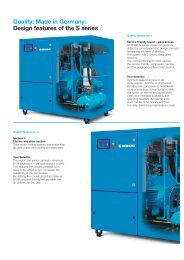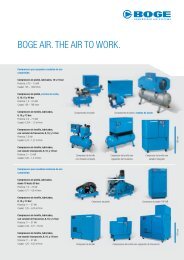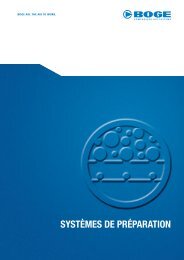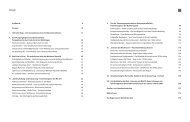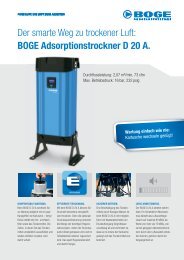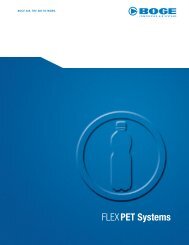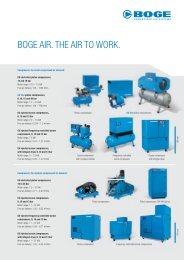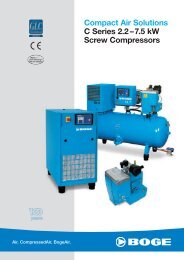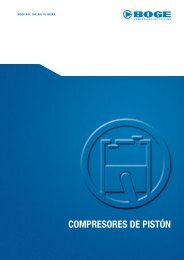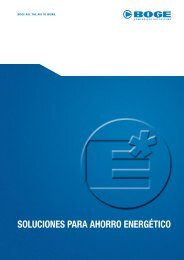Technical Paper Session Name: Energy ... - Boge Kompressoren
Technical Paper Session Name: Energy ... - Boge Kompressoren
Technical Paper Session Name: Energy ... - Boge Kompressoren
Create successful ePaper yourself
Turn your PDF publications into a flip-book with our unique Google optimized e-Paper software.
International Rotating Equipment Conference 2008, Düsseldorf<br />
investment and manpower cost. As this device only detects ultra sonic sound emissions it can<br />
be used during normal operation of<br />
the plant.<br />
There also is one way to find out the absolute leakage volume flow. During complete standstill<br />
of all compressed air users there still is air consumption because of the leakages. When the<br />
receiver is brought to a certain pressure value the compressors are switched of and the time for<br />
the pressure reduction in the receiver is measured. A pressure reduction from 8 bar to 6 bar in a<br />
1,000 l receiver over 2 minutes equals to a leakage volume flow of 1,000 l x (8-6) / 2 min =<br />
1,000 l/min. The costs for this leakage rate would be approx. 4,500 €/a. (see Fig. 3)<br />
Another method to measure the leakage rate is of course a complete measurement of the<br />
compressed air volume flow. The measured flow during times of standstill of all air consumers,<br />
for example during night or weekend, must then be leakages.<br />
One of the easiest ways to prevent leakage costs, at least during non shift times, is to shut<br />
down the compressors during this time, or, to prevent changing pressures in the receiver, to<br />
close a valve after the receiver.<br />
Operating pressure<br />
Another very important factor affecting the energy consumption of a compressed air system is<br />
the working pressure required. The pressure generated should always be at the minimum<br />
possible level to save energy. One important fact is: every 1 bar of additional pressure requires<br />
approx. 6-10 % more energy. This means, reducing the pressure by 1 bar immediately reduces<br />
the energy costs by 6-10 %. Therefore it is very important to reduce all pressure losses in the<br />
compressed air system from the receiver to the air consumer.<br />
6 bar<br />
dryer<br />
piping<br />
spiral connection<br />
2 filters<br />
pressure reducer<br />
12.3 bar 11.3 bar dp 0.3bar dp 1.5 bar dp 1.5 bar dp 1.5 bar dp 0.5 bar 6 bar<br />
Fig. 5: Example of a compressor station with unnecessary pressure losses<br />
Fig. 5 shows a compressor installation with many unnecessary pressure losses that cost<br />
money. Although only 6 bar is needed at the point of use the receiver pressure has to be 11.3<br />
bar and the compressor has to run with a maximum pressure of 12.3 bar, due to the necessary<br />
pressure hysteresis in the compressor cut-in and cut-out pressure settings. Connections with<br />
spiral hoses create a high pressure loss, pressure reducers should be avoided wherever<br />
possible, the piping diameter should be big enough to reduce pressure losses and filter<br />
elements should be replaced as early as possible. The pressure drop in this installation could<br />
certainly easily be reduced by 2 bar, reducing the energy consumption by approx. 15 %. Taking<br />
the 13,832 €/a energy costs of our example compressor this equals to 2,075 €/a. In most cases<br />
this saving potential can be used with almost no additional investment. Small things like early



